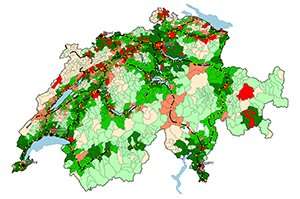Motorways shape the sociology of cities

The development of transport infrastructure is a central issue for states, which spend billions to connect cities. But what is their real effect on the municipalities concerned? Researchers from the University of Geneva (UNIGE) and the Università della Svizzera italiana (USI) looked at the evolution of the income composition of the population of cities in Switzerland once they are connected to the motorway network. By analyzing data from 1950 to 2010, they found that this new accessibility leads to substantial benefits for wealthy people, but indirect costs fall disproportionately on people with low incomes. The results can be read in The Economic Journal.
Every year, about CHF 2.5 billion is spent on maintaining and improving the Swiss national road network alone. These transport infrastructures can influence regional disparities, having an economic impact on the most isolated regions. But what are the real effects on municipalities once they are connected to the motorway network? "Several studies have already shown that one of the consequences is an increase in the population of the newly accessible municipalities, but no one has ever looked at the evolution of the composition of households belonging to different income categories that are induced by this change in these same municipalities. That is what we have done here," explains Frédéric Robert-Nicoud, professor at the Faculty of Economics and Management (GSEM) of the UNIGE.
To analyze the changing composition of the population in Swiss municipalities, the researchers analyzed four types of data for the period 1950–2010: taxpayer data for various income categories, population censuses, data from the Federal Office of Transport on the evolution of the motorway network and the household expenditure survey. "We did this work for 2480 Swiss municipalities, and more specifically for the 780 so-called non-urban municipalities—i.e. with fewer than 10,000 inhabitants—that were connected to the motorway network, in order to be able to observe the real effects of this new accessibility," explains Raphaël Parchet, professor at the Institute of Economic Research of the USI.
Beneficial effects mainly for the richest
The first result confirms the studies carried out for other countries concerning the increase in the population of municipalities newly connected to the motorway network, with a general increase of 14% in the number of households. Indeed, access to the motorway network improves access to employment, schools, shops, leisure activities, friends, and family circles. It also simplifies location choices for couples with two spouses active in the labor market, or for separated couples with shared childcare, for example. "But what is new is that the number of households in the richest 10% of the population (i.e. those with a taxable income of more than CHF 129,500 per year) is increasing by 42%, while the number of households below the median taxable income (earning less than CHF 58,900 per year)—i.e. the 50%—is increasing by only 5%," notes Frédéric Robert-Nicoud. However, initially, these municipalities had an under-representation of the richest households. "We can see that the connection to the motorway network leads to a better mix of households in these municipalities," says the Geneva researcher. The relative increase in the number of well-off households can be explained by the fact that they use the car more than modest households.
This first finding is part of the direct effects of accessibility, but the research team also highlights indirect effects. "When a municipality is connected to the motorway network, its access to employment, shops and activities is improved, which makes it attractive and leads to an increase in land and property prices," explains Raphaël Parchet. Thus, the burden of the increase in land prices falls disproportionately on the poorest households, since they spend about 40% of their income on housing, compared to 15% of income for the wealthiest households. Motorway access thus results in significant direct benefits for wealthy people, while the indirect costs fall mainly on people with modest incomes.
Population growth leads to urban sprawl
The final finding of this study concerns the physical footprint of metropolitan areas. "When a city is newly connected to the motorway network, it spreads out horizontally, because the connection to the motorway network makes the nearby countryside more attractive and accessible," notes Frédéric Robert-Nicoud. "In the long term, connection to the motorway network reduces the population of urban centers by 29%." The same is true for jobs, 18% of which are ultimately decentralized.
This study demonstrates the effect of the densification of the road network on the composition of municipalities. "Car ownership and car use is a luxury; housing is a necessity. Thus, the benefits of motorway access disproportionately accrue to the better-off sections of the population, and its costs disproportionately affect those on lower incomes. In the end, communities with access to the motorway network have become attractive to all, but it is the better-off who have benefited the most," concludes Raphaël Parchet.
More information: Stephan Fretz et al, Highways, Market Access, and Spatial Sorting, The Economic Journal (2021). DOI: 10.1093/ej/ueab070
Provided by University of Geneva



















